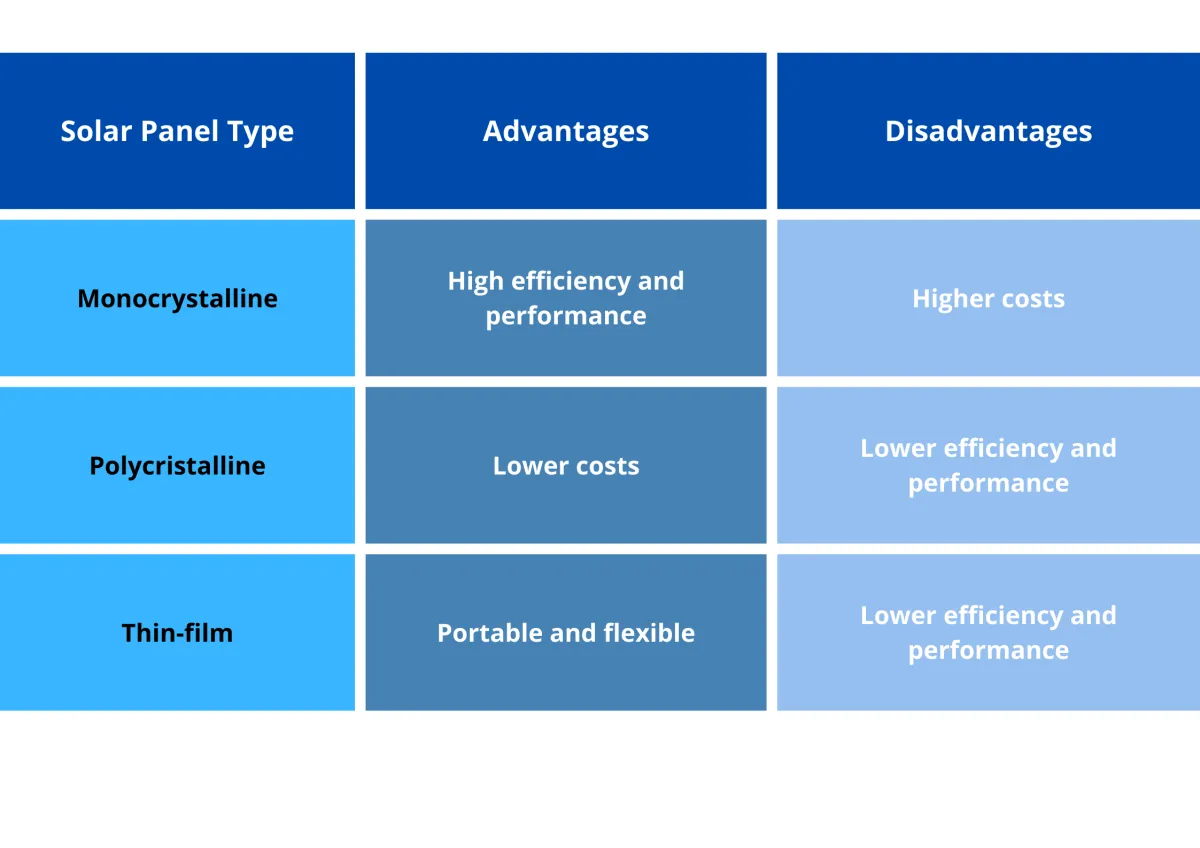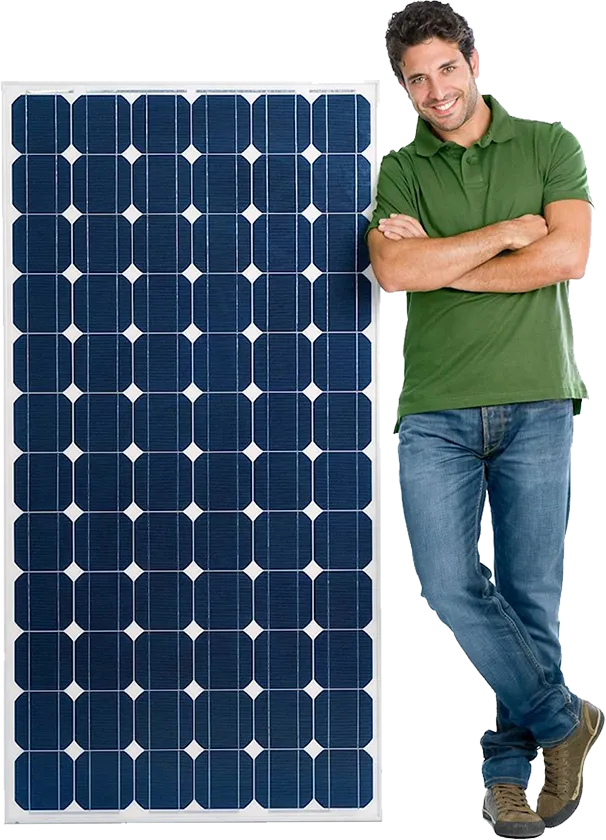Types of solar panels
The majority of the solar panel solutions now on the market fall into one of three categories: thin-film, polycrystalline, and monocrystalline (sometimes known as multi-crystalline). These solar panels differ in terms of how they are constructed, aesthetic appeal, functionality, price, and the installations each is most suitable for. One choice may be better suited than the others depending on the type of installation you're considering.
Key takeaways about the different types of solar panels
The three main types of solar panels are monocrystalline, polycrystalline and thin-film
Monocrystalline solar panels are the most efficient
Polycrystalline solar panels can be the most cost effective
Thin-film solar panels can be the best for unorthodox roof styles
The major types of solar panels
Solar panels come in three main varieties: thin-film, polycrystalline, and monocrystalline. The solar panel type that is suitable for your installation will depend on elements particular to your own property and desired system characteristics. Each kind has its own distinct benefits and drawbacks.

Below, we’ll break down some common questions and concerns about solar panels and how different types of panels have varying characteristics.
Which kind of solar panel is ideal?
Out of all solar panels, crystalline panels have the best efficiency.
The most effective crystalline panels are monocrystalline ones, which have an efficiency of between 15 and 20%.
The most economical choice may be polycrystalline panels, which have an efficiency of 15–17%.
The most durable solar panels are thin film solar panels, which are ideal for unusual roof designs.
The price of various solar panel types varies.
Each type of panel has a varied cost since the production procedures for monocrystalline, polycrystalline, and thin-film are different.
Monocrystalline solar panels are the most expensive choice.
Monocrystalline solar panels are perhaps the most expensive form of solar panel available. This is primarily attributable to the manufacturing process; as solar cells are created from a single silicon crystal, producers must pay for the crystals' production. This technique, also known as the Czochralski process, uses a lot of energy and wastes silicon (that can later be used to manufacture polycrystalline solar cells).
Polycrystalline solar panels: middle of the road
Generally speaking, polycrystalline solar panels are less expensive than monocrystalline ones. This is due to the fact that silicon fragments rather than a single, pure silicon crystal are used to make the cells. This makes it possible to manufacture cells considerably more cheaply for both manufacturers and ultimately end users.
Thin-film solar panels: it depends!
What you pay for thin-film solar panels will primarily rely on the type of thin-film panel; CIGS solar panels are far more expensive to construct than either CdTe or amorphous silicon solar panels.
Regardless of how much the panels themselves cost, installing a thin-film solar panel system may be less expensive overall than installing a monocrystalline or polycrystalline system since it requires less labor. Due to their reduced weight and greater maneuverability, thin-film solar panels require less work during installation because they are simpler for installers to take up onto rooftops and fasten. As a result, labor costs will be lower, which will help make the entire cost of a solar installation lower.
What materials are used in solar panels?
Solar cells are a semiconducting substance that turns light into electricity and generates electricity. Silicon is the substance that serves as a semiconductor the most frequently while making solar cells.
What material do crystalline solar panels contain?
Silicon wafers are used to make the cells in solar panels that are both monocrystalline and polycrystalline. Wafers are arranged into rows and columns to create a rectangle, which is then covered with a glass sheet and framed together to create a monocrystalline or polycrystalline panel.
Despite having silicon-based cells in common, monocrystalline and polycrystalline solar panels have different silicon compositions. A single, pure silicon crystal is used to create monocrystalline solar cells. Instead, the components of polycrystalline solar cells are silicon crystal shards that have been fused together in a mold before being sliced into wafers.
What are thin-film solar panels made out of?
Different materials can be used to create thin-film solar panels, as opposed to monocrystalline and polycrystalline solar panels. Cadmium telluride is used to create the most common type of thin-film solar panel (CdTe). Manufacturers sandwich a layer of CdTe between transparent conducting layers that assist capture sunlight to create this kind of thin-film panel. A glass layer is also present on top of this kind of thin-film technology as protection.
Amorphous silicon (a-Si), which is comparable to the makeup of monocrystalline and polycrystalline panels, can also be used to create thin-film solar panels. Although silicon is a component of these thin-film panels, they are not composed of solid silicon wafers. They are made out of non-crystalline silicon that is layered over glass, plastic, or metal.
The last form of thin-film technology is Copper Indium Gallium Selenide (CIGS) panels, which are also very popular. All four components of CIGS panels are sandwiched between two conductive layers (such as glass, plastic, aluminum, or steel), with electrodes positioned on the front and back of the material to collect electrical currents.
Which panel type is most suitable for your installation?
The particulars of your property and situation will play a significant role in your decision regarding the sort of solar panel you choose for your system. Each type of solar panel—monocrystalline, polycrystalline, and thin-film—has benefits and drawbacks, and the best option for your land and project objectives will vary.
Installing less efficient, less expensive polycrystalline panels can help property owners with lots of room for solar panels save money up front. Installing high-efficiency, monocrystalline solar panels will help you reduce your electricity costs to the fullest extent possible if you have a small amount of available space.
When placing solar equipment on a large, commercial roof that cannot support the added weight of conventional solar equipment, thin-film panels are typically the choice. Thin-film panels' lower efficiency can also be tolerated on these kinds of roofs because there is more space for them. Furthermore, thin-film panels can occasionally be a practical option for mobile solar systems, such as those on RVs or boats.
Start your solar journey today!
Obtain Solar is the nation’s online solar marketplace: We will connect you with solar companies in your area, who compete for your business with custom solar quotes tailored to fit your needs. Get your quote now or call us at 949-228-9497

Feel Free To Contact Us

See why Americans across the country are enjoying the advantages of home solar with Obtain Solar and get a free quote today. You’ll be connected with one of our expert Solar Advisors who will help you every step of the way.

Looking to go solar and save on your electric bills? Let Obtain Solar help you find the best solar solution for your home. We'll search the industry for the best options and provide an unbiased review to help you find a lifetime savings on your electricity bill. Going solar has never been easier!
Contact Us

949-228-9497
27637 Laguna Niguel, California 92677 USA.
Copyright 2022 Obtain Solar. All Right Reserved





